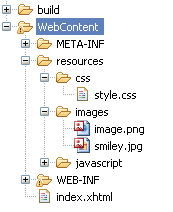如何将JSF图像资源引用为CSS背景图像url
我经常使用 image 属性更改按钮的图像,但有人告诉我使用 .css 是一个很好的做法 我尝试过,但我做不到,我做错了什么?这就是我所做的:
1-我的项目的资源存储如下:

2-这是我创建用于访问图像的 style.css
.c2 {
background: url(/resources/images/smiley.jpg);
}
3-这是我从页面正文访问 css 的方式(我确信这是正确的,因为同一文档中的其他类在该文档中的其他标签中工作页)
<h:outputStylesheet library="css" name="style.css" />
4-这是如何创建一个使用适当的 css 类的示例命令按钮
<h:commandButton styleClass="c2"/>
我认为问题出在 .css 中,我尝试了几种组合,但没有成功:
background-image: url(/resources/images/smiley.jpg);
background: url(resources/images/smiley.jpg);
background: url(smiley.jpg);
background: url(../smiley.jpg);
在哪里错误?
更新 我设法通过以下代码使其工作:
.c2 {
background: url("#{resource['images:smiley.jpg']}");
}
注意使用 css(右)和使用图像属性(左)时的区别

我该如何解决此问题以便显示保留图像?
I often, change the images of my buttons using the image attribute, but someone told me that it is a good practice to do it using .css
I tried but i cant, what i am doing wrong? This is what i did:
1-The resources of my project are stored like this:

2-This is how i created the style.css for accessing the image
.c2 {
background: url(/resources/images/smiley.jpg);
}
3-This is how i access the css from the body of my page(Im sure this is correct because other classes in the same document works in other tags in this page)
<h:outputStylesheet library="css" name="style.css" />
4-This is how create a sample commandButton that uses the appropiated css class
<h:commandButton styleClass="c2"/>
I think the problem is in the .css, i tried a few combinations but none worked:
background-image: url(/resources/images/smiley.jpg);
background: url(resources/images/smiley.jpg);
background: url(smiley.jpg);
background: url(../smiley.jpg);
Where is the mistake?
update
I managed to make it work by the following code:
.c2 {
background: url("#{resource['images:smiley.jpg']}");
}
Notice the difference when i use css(right) and when i use image attribute(left)

How could i solve this so the hold image is shown?
如果你对这篇内容有疑问,欢迎到本站社区发帖提问 参与讨论,获取更多帮助,或者扫码二维码加入 Web 技术交流群。

绑定邮箱获取回复消息
由于您还没有绑定你的真实邮箱,如果其他用户或者作者回复了您的评论,将不能在第一时间通知您!

发布评论
评论(2)
因为我在这个问题上遇到了一点困难,虽然 BalusC 已经回答了这个问题,但也许可以评论为什么会发生这种情况。我有 5 个 EAR 项目,其中包含捆绑的 WAR 和 EJB 项目。然后我自己部署了一个独立的 WAR 项目。以下代码对所有 EAR 都能完美运行:
“img”文件夹位于 WEB-INF 文件夹内,但对于 EAR 项目,它不起作用,甚至无法通过手动输入 URL 将图片加载到浏览器中。我验证了生成的 html 100% 准确。因此,所有有关“资源”的讨论都让我想到这可能是一种“安全”?某种问题在 WAR 和 EAR 部署之间似乎没有意义,因此我在 Web 应用程序的根目录中创建了一个“资源”文件夹,例如在 Eclipse 中,其父文件夹是 WebContent,然后向名为“img”的资源添加了一个子文件夹,将我的图像放在那里。
代码现在如下所示:
现在图像已显示。再次强调,我并不是想劫持 balusc 的彻底答案,我只是想提出它,以防有人遇到类似的问题。如果有人要我单独开个Q和AI会的!
啊,是的,这是在 JBoss EAP 7、Servlet API 3.1、Facelets 2.2、Rich Faces 4.5.17 Java 1.8 上。
编辑@Basil-Bourque答案WEB-INF 在 Java EE Web 应用程序中的用途 似乎相当相关
,但它仍然有点令人困惑,因为 EAR 中的 WAR 如何访问该位置而不是独立的 WAR?
Since I struggled with this a little bit and while BalusC has already answered the question but might be able to comment as to why this is happening. I have 5 EAR projects consisting of a bundled WAR and EJB projects. I then have one standalone WAR project deployed on its own. The following code worked perfect with all the EAR's:
Where the "img" folder was within the WEB-INF folder but for the EAR project, it would not work and it wouldnt even load the picture in the browser by manually typing in the URL. I verified the resulting html was 100% accurate. So all the talk of "resources" got me thinking that maybe it was a ?security? issue of some sort which doesnt seem to make sense between the WAR and EAR deployments so I created a "resources" folderin the root of the web application, e.g. in Eclipse its parent would be WebContent, then added a subfolder to resources called "img", placed my image in there.
The code now looks like this:
And now the image is displayed. Again not trying to hijack balusc's thorough answer, I just wanted to bring it up in case anyone ran into a similar issue. If someone wants me to open a separate Q and A I will!
Ahh yes, this was on JBoss EAP 7, Servlet API 3.1, Facelets 2.2, Rich Faces 4.5.17 Java 1.8.
Edit @Basil-Bourque answer What is WEB-INF used for in a Java EE web application seems fairly relevant
But its still a little confusing in that how can a WAR within an EAR access that location but not a standalone WAR?
当通过
FacesServlet通过/javax.faces.resource/*。查看生成的指向相关样式表的元素,您就会明白。您必须更改所有
url()依赖项才能使用#{resource['library:location']}代替。然后,JSF 将自动用正确的路径替换它。给定您的文件夹结构,您需要替换为
假设您的 web 应用程序上下文名称为 Playground,并且您的 FacesServlet 映射到 *.xhtml,那么上面的内容应该在返回的 CSS 文件中结束,如下所示。
应该注意的是,JSF 实现将仅在 CSS 文件的第一次请求期间确定它是否包含 EL 表达式。如果没有,那么出于效率考虑,它将不再尝试 EL 评估 CSS 文件内容。因此,如果您第一次将 EL 表达式添加到 CSS 文件,那么您需要重新启动整个应用程序,以便让 JSF 重新检查 CSS 文件。
如果您想要引用组件库(例如 PrimeFaces)中的资源,请在库名称前加上前缀,并用
:分隔。例如,当您使用由primefaces-start标识的 PrimeFaces“Start”主题时,这将生成为
另请参阅:
与具体问题无关,您使用
库的方式与完全正确。它是所有相关 CSS/JS/图像资源的通用标识符/子文件夹。关键思想是能够通过更改库(可以通过 EL 来完成)来更改整个外观。然而,您似乎依赖于默认库。在这种情况下,您可以从#{resource}中省略library。另请参阅:
When importing CSS stylesheets by
<h:outputStylesheet>, the stylesheet is imported and processed by theFacesServletthrough/javax.faces.resource/*. Look at the generated<link>element pointing to the stylesheet in question and you'll understand.You have to change all
url()dependencies to use#{resource['library:location']}instead. JSF will then auto-substitute it with the right path. Given your folder structure, you need to replaceby
Assuming that your webapp context name is
playgroundand that yourFacesServletis mapped on*.xhtml, then the above should end up in the returned CSS file as followsNoted should be that the JSF implementation will for determine only during the first request on the CSS file if it contains EL expressions. If it doesn't then it will for efficiency not anymore attempt to EL-evaluate the CSS file content. So if you add an EL expression to a CSS file for the first time, then you'd need to restart the whole application in order to get JSF to re-check the CSS file.
In case you wanted to reference a resource from a component library such as PrimeFaces, then prefix the library name, separated with
:. E.g. when you're using PrimeFaces "Start" theme which is identified byprimefaces-startThis will be generated as
See also:
Unrelated to the concrete problem, the way how you use the
libraryis not entirely right. It's meant to be the common identifier/subfolder of all related CSS/JS/image resources. The key idea is to be able to change the entire look'n'feel by just changing thelibrary(which can be done by EL). You seem however to be relying on the default library. In that case, you could just omit thelibraryfrom your<h:outputStylesheet>and#{resource}.See also: